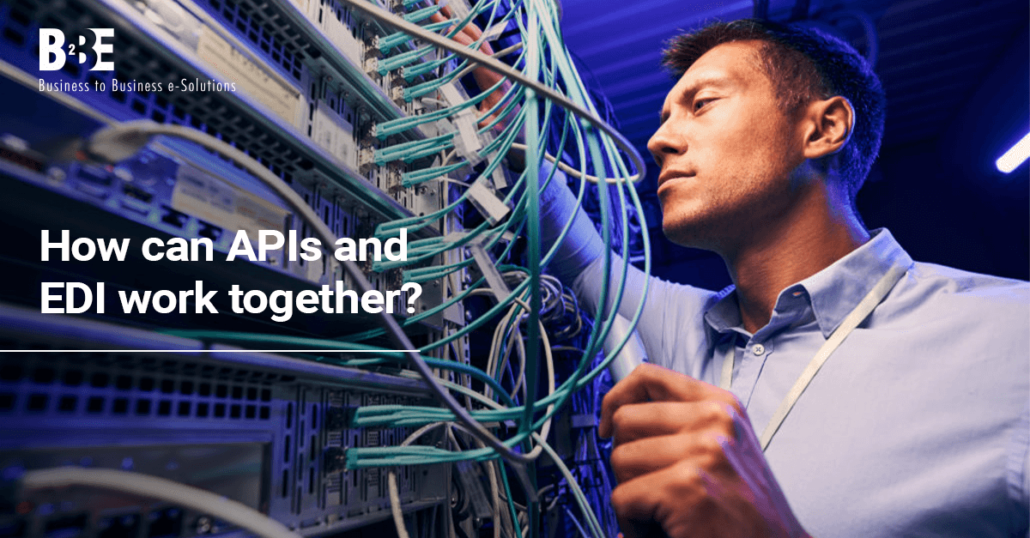In last week’s article ‘API: The Future of EDI’, we outlined two main systems for data transmission across supply chains. These systems are Échange de données informatisées (EDI), which has integrated external B2B systems since the 1970s, and Application Programming Interfaces (APIs), which supplies real-time information accessible by other applications. Companies can also use specific APIs for the same B2B integration as EDI. For this reason, people often view APIs as a replacement to the older solution of EDI. However, this article will look at how these systems complement each other, and how API and EDI can work together.
API and EDI: Complementary solutions
We saw last week how EDI and APIs both have their shortcomings. For this reason, it is important for organisations to support both solutions. Particularly to avoid missing the opportunities for growth that both can bring when working together seamlessly. APIs’ real-time information transmission and EDI’s file-based batch process can interact with and benefit from each other. All while running on the same platform. Adding the data capabilities of APIs to an existing EDI program can evolve a company’s system without forcing them to choose one program over the other. It also removes the need to invest in a separate API infrastructure.
On the other hand, using a blended solution will allow companies to better use the resources that they already enjoy. They can then improve on this to meet their goals while receiving backup from the new capabilities of innovative technologies. With this, companies can enjoy the best of both worlds: a wide-reaching B2B integration system with a combination of EDI working natively, but with the possibility of extending to API connectivity, allowing for greater efficiency, effectiveness, and optimised collaboration. This will offset the shortcomings of both systems while effectively using both sets of strengths. Namely EDI’s reliability, and API’s versatility.
The best of both worlds
For trading partners that are not currently using EDI, APIs can be a workable alternative. However, EDI can better perform batch processing. The combination of these two systems allows companies to apply the best technology for the situation. For example, the shipping industry relies heavily on real-time information and load-tender responses for companies to remain competitive. Conversely, government mandates and industry initiatives are well-suited to how EDI has developed to support new standards for mission-oriented goals. Since different companies’ systems have different requirements for integration, companies need the option of what EDI and API can bring to the table.
An organisation’s ability to adapt to changing requirements depend hugely on the resources they have available. This is why a single platform that combines API and EDI unlocks the necessary versatility for a rapidly developing supply chain network. A joint approach allows you to onboard a greater number of new trading partners faster and respond to new requirements. This is what can be achieved by combining the simplicity and speed of API with the tested onboarding of EDI. With API and EDI combined in one platform, it is possible to view all supply chain transactions through a single interface.
API, EDI and integration
Bridging the two solutions requires the use of hybrid integration capabilities. To improve data-sharing capabilities, organisations must be able to connect the on-premises EDI solution and API cloud-based functions. Any integration solution needs to be able to translate the data into a format that is compatible with the other. This will enable the two sets of data to be combined into a single, easy-to-comprehend format. It also means that whatever system is receiving the data can do so in a format that it understands. This will allow more transactional data to be transmitted in-house and externally faster and more easily than before.
Conclusion
We hope that organisations continue to learn how EDI and API work better together than apart. Although API might represent the future to many, that should not mean EDI belongs solely to the past. In a rapidly changing and increasingly global ecosystem for supply chains, the more tools that companies have available to them will mean the difference between success and failure. By finding innovative ways to use proven solutions like EDI and combining them with the possibilities unlocked by new technology, global supply chains can continue to adapt.
If you’d like to find out more about EDI and how it can optimise your business processes, get in touch with us and a member of the team will be happy to help.

